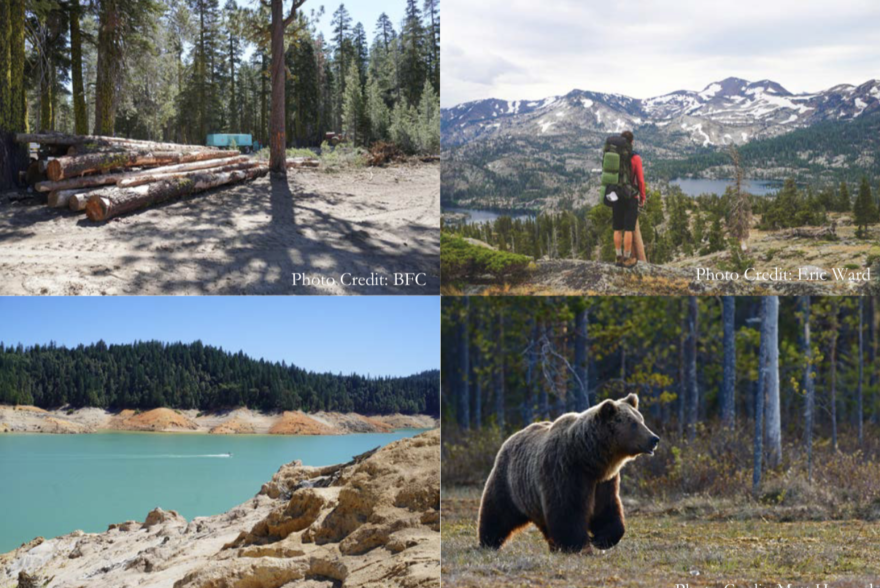A landscape in need: Financing future forests in the Tahoe-Central Sierra


Restoration projects can restore healthy forest functions and increase their resilience to disturbances, but rely on substantial and often constrained funding and personnel. Blue Forest’s Forest Resilience Bond (FRB) reduces these barriers by identifying public and private funding sources willing to pay for the benefits of forest restoration.
Written by: Kirsten Hodgson, Project Associate
Fire is an integral and necessary part of many of California’s ecosystems. For millennia, a combination of natural and human ignitions adaptively maintained these landscapes, protecting resources and fostering biodiversity. Now, however, California’s forests are largely degraded and susceptible to threats like drought, insect outbreaks, and record-breaking wildfires, the result of climate change and more than a century of near-total fire suppression.
Restoration projects can restore healthy forest functions and increase their resilience to disturbances, but rely on substantial and often constrained funding and personnel. Blue Forest’s Forest Resilience Bond (FRB) reduces these barriers by identifying public and private funding sources willing to pay for the benefits of forest restoration. Doing so requires an intimate understanding of both the ecosystem services provided by a forest and the interests of local and downstream beneficiaries. Now, a report by UC Santa Barbara master’s students details how congruences between the locations of landscape benefits and stakeholder values across a landscape can be used to identify focal locations for restoration.
The report focuses on the 2.4-million acre Tahoe-Central Sierra Initiative (TCSI) landscape, an area comprising six densely forested watersheds, including the Lake Tahoe Basin. The forests of the TCSI provide critical ecosystem services to California communities, including clean water, recreation, carbon sequestration, and habitat for a diversity of species. They are also at high risk of fire and in need of restoration.
Modeling meets participatory mapping: the approach
The study team used a dual approach to examine opportunities for restoration in the TCSI based on modeled ecosystem service distributions and locations of interest to stakeholder organizations. A survey of forest collaborative member organizations’ most salient forest ecosystem services, risks, and threats was used to inform modeling of ecosystem services in current and future climate and restoration scenarios.
In follow-up interviews, participants identified high-yielding locations for key ecosystem services. For each scenario, these mapped priority locations could then be compared with the four modeled services: water yield, sedimentation, biodiversity, and recreation, to identify areas where both models and stakeholders agree that restoration would yield great benefits.
Stakeholders and models agree on important locations: congruence
The survey indicated that the most valued ecosystem services among forest-focused organizations in the TCSI are general health and resilience of the forest, water availability, retained sediment and avoided runoff into waterways, and recreation. Wildfires are overwhelmingly the most salient threat. Generally, stakeholder-identified locations of each ecosystem service overlapped with highly ranked watersheds from the modeling approach, indicating that local organizations are knowledgeable about the locations of ecosystem services in their region. They are also largely interested in collaborating to reduce the threat of wildfire through forest restoration such as thinning and prescribed burning.
Modeled changes in biodiversity, water availability, and sediment retention showed that all three will be clearly impacted by future climate and land management, although the exact impact depends on the ecosystem service and the precise future trajectory used. Still, spatial patterns are generally well maintained over time, and focusing on watersheds that are high-provisioning now could protect important watersheds in the future. Recreation modeling indicated potential decreases in recreation in the months during and after fire events, with implications for the economies of fire-prone tourist regions like the TCSI.
The general alignment between modeled results and stakeholder interests allowed the team to narrow down the 2.4-million acre TCSI landscape and pinpoint three watersheds that may be priority locations for restoration. While further research and exploration is necessary, the authors hope that this study provides inspiration for future projects, as well as a roadmap for how combined modeling and interviews can help identify priority projects in new regions.
Beyond the TCSI
The TCSI is not the only forested landscape in the American West that needs restoration–in 2021, the State of California and US Forest Service jointly announced a goal to restore 1 million acres of California forests annually by 2025. Forest Resilience Bonds are a part of the solution, just one way to approach this goal, and analyses like this one can help to identify new locations and stakeholders that will decrease barriers and increase the pace and scale of forest restoration.